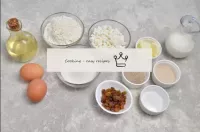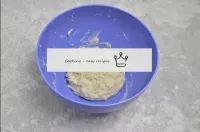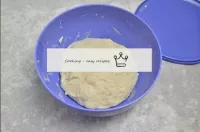Easter cake curd
 2 servings5 hours
2 servings5 hours
Wheat flour - 250 g, Eggs - 1 pc., Egg yolks - 1 pc., Cottage cheese - 125 g, Butter - 30 g, Milk - 50 gr, Sugar - 115 gr, Vanilla sugar - 10 gr, Dry yeast - 4 gr, Raisins - 50 gr, Vegetable oil - 1 tea liter, Salt - to taste, Sugar - 200 gr, Gelatin - 5 gr, Water - 95 ml

How to make Easter cottage cheese cake with cottage cheese? Prepare the products. Take the fattest cottage cheese, I have 9%. Choose natural, high-quality cottage cheese, not grained and not pasty. The same applies to oil. Take it out of the fridge beforehand to soften. Eggs should also be warm, take them out with the oil. In addition to vanilla sugar, you can put cinnamon, cardamom, saffron. And along with raisins - candied fruits and nuts.

First of all, prepare the dough for the cake. To do this, pour into a deep bowl in which you plan to knead dough, dry yeast and a teaspoon of sugar. Pour warm milk over it all. Warm, but not hot, so as not to kill live yeast. Stir and pour in a teaspoon of flour. Stir the opara again until smooth, cover the bowl and leave to stand for 20 minutes.

While the opara rises, prepare the other ingredients. Beat the curd with a submerged blender along with the soft butter until smooth. If you don't have a blender, then wipe the cottage cheese through a sieve. It is better to do this necessarily - the dough will be more uniform, without lumps.

Drive the egg and yolk into another bowl. Whisk them with regular and vanilla sugar until fluffy, light.

Opara, meanwhile, will rise and bubble - this means that yeast is active and ready to work. If this did not happen, replace them.

Add the beaten eggs and grated cottage cheese with the butter to the opara. Pour in a pinch of salt - it will balance the taste.

Mix the mass until smooth.

Sift flour to it. I advise you to start with 200 grams, as it may need more or less of the specified amount. Stir the dough first with a whisk, and when it becomes thick - with your hands. You can lubricate your hands with vegetable oil to make it more convenient to knead. I put on gloves.

Knead the dough for 15 minutes, adding flour as needed. It should become uniform, but still remain soft and a little sticky. It took me a little less flour, about 230 grams.

Assemble the dough into a ball, cover the bowl with a towel or lid and place it in a warm place for 2 hours. I usually put it in the oven (not working). During this time, the dough will increase 2 times.

Rinse the raisins (as well as candied fruits, if you use them) well, dry and roll in flour - so they will be evenly distributed over the dough. Wash the dough, pour raisins into it and stir it in with your hand.

Divide the dough into equal parts by the number of cakes you plan to bake. I have two shapes measuring 10 * 9 cm (10 is the diameter of the bottom).

Place the dough pieces in the moulds, filling them in about half. Then put them back in a warm place for an hour.

Bake the cakes in an oven preheated to 160 ° C for 30 to 40 minutes, depending on their size. The cakes should brown from above. Remove the finished cakes from the oven and cool completely.

Prepare the icing. From this amount of products you will get a lot of glaze, at least 6 cakes. It will be inconvenient to measure gelatin for a smaller portion.

Pour 35ml of water over the gelatin, stir and leave to swell. Time will depend on the type of gelatin. I have a fast-acting one - it swells in 5 minutes. How much you need, read on the package.

Pour sugar into a sauté pan, pour the remaining water (60ml) over it. Stir and place on medium heat. Boil the syrup, stirring, practically until boiling, but do not boil. As soon as the first bubbles appear, remove from the heat.

Put the swollen gelatin in the hot syrup. Mix until completely dissolved. Cool the mass a little.

And then whisk with a mixer until white and thick.

Cover the ready-made cake with the glaze. Take your time, it will be liquid first and can drain. But do not drag too long either - gelatin, cooling, will begin to freeze.

Decorate the cake as you wish. Serve to the table. Enjoy your meal!
 2 servings
2 servings How to make Easter cottage cheese cake with cottage cheese? Prepare the products. Take the fattest cottage cheese, I have 9%. Choose natural, high-quality cottage cheese, not grained and not pasty. The same applies to oil. Take it out of the fridge beforehand to soften. Eggs should also be warm, take them out with the oil. In addition to vanilla sugar, you can put cinnamon, cardamom, saffron. And along with raisins - candied fruits and nuts.
How to make Easter cottage cheese cake with cottage cheese? Prepare the products. Take the fattest cottage cheese, I have 9%. Choose natural, high-quality cottage cheese, not grained and not pasty. The same applies to oil. Take it out of the fridge beforehand to soften. Eggs should also be warm, take them out with the oil. In addition to vanilla sugar, you can put cinnamon, cardamom, saffron. And along with raisins - candied fruits and nuts.  First of all, prepare the dough for the cake. To do this, pour into a deep bowl in which you plan to knead dough, dry yeast and a teaspoon of sugar. Pour warm milk over it all. Warm, but not hot, so as not to kill live yeast. Stir and pour in a teaspoon of flour. Stir the opara again until smooth, cover the bowl and leave to stand for 20 minutes.
First of all, prepare the dough for the cake. To do this, pour into a deep bowl in which you plan to knead dough, dry yeast and a teaspoon of sugar. Pour warm milk over it all. Warm, but not hot, so as not to kill live yeast. Stir and pour in a teaspoon of flour. Stir the opara again until smooth, cover the bowl and leave to stand for 20 minutes.  Español
Español Français
Français Português
Português Русский
Русский 简体中文
简体中文 繁體中文
繁體中文 日本語
日本語 한국어
한국어 العربية
العربية Türkçe
Türkçe Қазақ
Қазақ Deutsch
Deutsch Italiano
Italiano Українська
Українська
 While the opara rises, prepare the other ingredients. Beat the curd with a submerged blender along with the soft butter until smooth. If you don't have a blender, then wipe the cottage cheese through a sieve. It is better to do this necessarily - the dough will be more uniform, without lumps.
While the opara rises, prepare the other ingredients. Beat the curd with a submerged blender along with the soft butter until smooth. If you don't have a blender, then wipe the cottage cheese through a sieve. It is better to do this necessarily - the dough will be more uniform, without lumps.  Drive the egg and yolk into another bowl. Whisk them with regular and vanilla sugar until fluffy, light.
Drive the egg and yolk into another bowl. Whisk them with regular and vanilla sugar until fluffy, light.  Opara, meanwhile, will rise and bubble - this means that yeast is active and ready to work. If this did not happen, replace them.
Opara, meanwhile, will rise and bubble - this means that yeast is active and ready to work. If this did not happen, replace them.  Add the beaten eggs and grated cottage cheese with the butter to the opara. Pour in a pinch of salt - it will balance the taste.
Add the beaten eggs and grated cottage cheese with the butter to the opara. Pour in a pinch of salt - it will balance the taste.  Mix the mass until smooth.
Mix the mass until smooth.  Sift flour to it. I advise you to start with 200 grams, as it may need more or less of the specified amount. Stir the dough first with a whisk, and when it becomes thick - with your hands. You can lubricate your hands with vegetable oil to make it more convenient to knead. I put on gloves.
Sift flour to it. I advise you to start with 200 grams, as it may need more or less of the specified amount. Stir the dough first with a whisk, and when it becomes thick - with your hands. You can lubricate your hands with vegetable oil to make it more convenient to knead. I put on gloves.  Knead the dough for 15 minutes, adding flour as needed. It should become uniform, but still remain soft and a little sticky. It took me a little less flour, about 230 grams.
Knead the dough for 15 minutes, adding flour as needed. It should become uniform, but still remain soft and a little sticky. It took me a little less flour, about 230 grams.  Assemble the dough into a ball, cover the bowl with a towel or lid and place it in a warm place for 2 hours. I usually put it in the oven (not working). During this time, the dough will increase 2 times.
Assemble the dough into a ball, cover the bowl with a towel or lid and place it in a warm place for 2 hours. I usually put it in the oven (not working). During this time, the dough will increase 2 times.  Rinse the raisins (as well as candied fruits, if you use them) well, dry and roll in flour - so they will be evenly distributed over the dough. Wash the dough, pour raisins into it and stir it in with your hand.
Rinse the raisins (as well as candied fruits, if you use them) well, dry and roll in flour - so they will be evenly distributed over the dough. Wash the dough, pour raisins into it and stir it in with your hand.  Divide the dough into equal parts by the number of cakes you plan to bake. I have two shapes measuring 10 * 9 cm (10 is the diameter of the bottom).
Divide the dough into equal parts by the number of cakes you plan to bake. I have two shapes measuring 10 * 9 cm (10 is the diameter of the bottom).  Place the dough pieces in the moulds, filling them in about half. Then put them back in a warm place for an hour.
Place the dough pieces in the moulds, filling them in about half. Then put them back in a warm place for an hour.  Bake the cakes in an oven preheated to 160 ° C for 30 to 40 minutes, depending on their size. The cakes should brown from above. Remove the finished cakes from the oven and cool completely.
Bake the cakes in an oven preheated to 160 ° C for 30 to 40 minutes, depending on their size. The cakes should brown from above. Remove the finished cakes from the oven and cool completely.  Prepare the icing. From this amount of products you will get a lot of glaze, at least 6 cakes. It will be inconvenient to measure gelatin for a smaller portion.
Prepare the icing. From this amount of products you will get a lot of glaze, at least 6 cakes. It will be inconvenient to measure gelatin for a smaller portion.  Pour 35ml of water over the gelatin, stir and leave to swell. Time will depend on the type of gelatin. I have a fast-acting one - it swells in 5 minutes. How much you need, read on the package.
Pour 35ml of water over the gelatin, stir and leave to swell. Time will depend on the type of gelatin. I have a fast-acting one - it swells in 5 minutes. How much you need, read on the package.  Pour sugar into a sauté pan, pour the remaining water (60ml) over it. Stir and place on medium heat. Boil the syrup, stirring, practically until boiling, but do not boil. As soon as the first bubbles appear, remove from the heat.
Pour sugar into a sauté pan, pour the remaining water (60ml) over it. Stir and place on medium heat. Boil the syrup, stirring, practically until boiling, but do not boil. As soon as the first bubbles appear, remove from the heat.  Put the swollen gelatin in the hot syrup. Mix until completely dissolved. Cool the mass a little.
Put the swollen gelatin in the hot syrup. Mix until completely dissolved. Cool the mass a little.  And then whisk with a mixer until white and thick.
And then whisk with a mixer until white and thick.  Cover the ready-made cake with the glaze. Take your time, it will be liquid first and can drain. But do not drag too long either - gelatin, cooling, will begin to freeze.
Cover the ready-made cake with the glaze. Take your time, it will be liquid first and can drain. But do not drag too long either - gelatin, cooling, will begin to freeze.  Decorate the cake as you wish. Serve to the table. Enjoy your meal!
Decorate the cake as you wish. Serve to the table. Enjoy your meal!